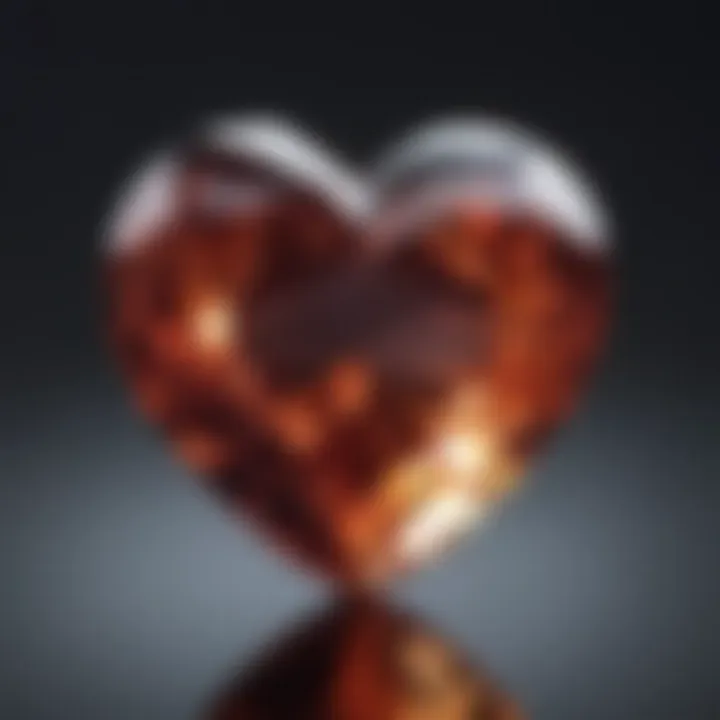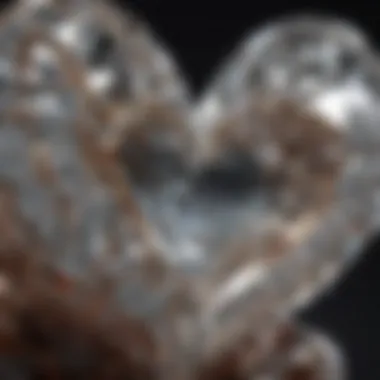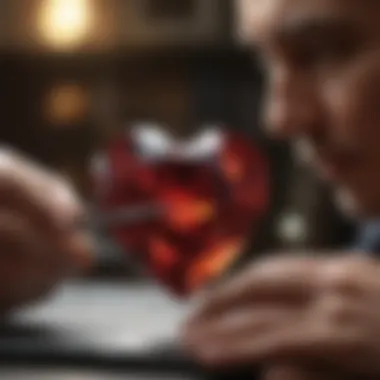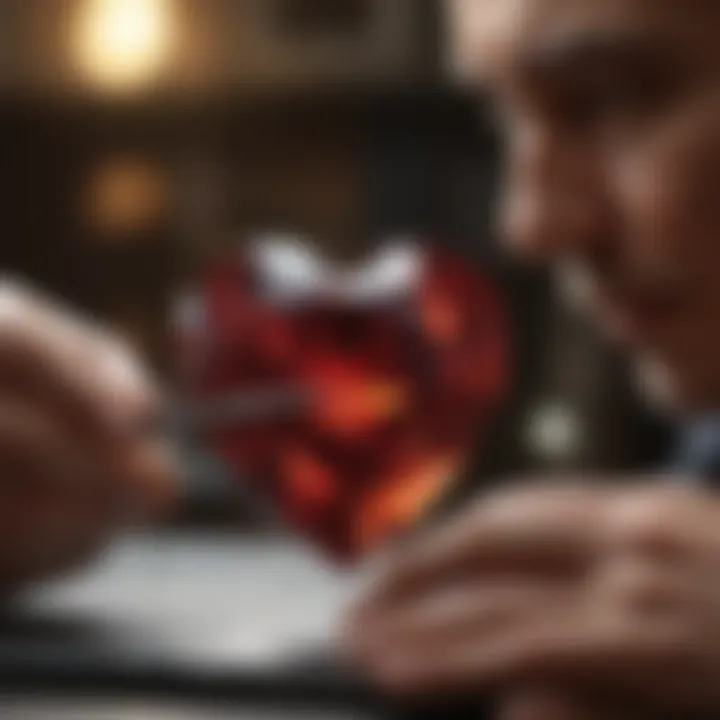Mastering the Craft of Heart-Shaped Gemstones


Intro
Heart-shaped gemstones hold a unique place in the world of both jewelry and craftsmanship. This distinctive shape has not only become emblematic of love and affection but also speaks volumes about the artistry and precision involved in gemstone cutting. As collectors and enthusiasts delve deeper into this captivating realm, understanding the nuances behind heart-shaped gemstones becomes vital. From the cutting techniques to the historical significance, each facet of these stones contributes to their allure and desirability.
Gemstone Overview
Definition and Characteristics
Gemstones are precious or semi-precious minerals that possess beauty and are suitable for adornment. Their value is often determined by factors like color, clarity, cut, and carat weight—collectively known as the "Four Cs." A heart-shaped gemstone is a specific cut that evokes strong emotions, often utilized in romantic settings, making it popular for engagement rings and other significant jewelry pieces.
Its defining characteristics include a symmetrical design that mimics a heart. This shape requires exceptional skill from the cutter to ensure that the gemstone reflects light beautifully and maintains its integrity.
Classification of Gemstones
Gemstones can be broadly classified into two categories: precious and semi-precious.
- Precious gemstones, which include diamonds, rubies, sapphires, and emeralds, are generally more sought after and command higher prices due to their perceived rarity and beauty.
- Semi-precious gemstones, such as amethyst, garnet, and aquamarine, can also be stunning, but often don’t have the same market prestige as their precious counterparts.
Heart-shaped stones can appear in both categories, depending on the material and quality of the gemstone. For example, a heart-cut diamond is often viewed as a top-tier choice, whereas a heart-cut amethyst could appeal to those with more budgetary constraints.
Historical Significance
Ancient Uses and Cultural Importance
Throughout history, gemstones have played significant roles in various cultures, often being believed to hold mystical powers or serve as symbols of status. Ancient civilizations utilized gemstones in various forms, from jewelry to talismans, attributing them with healing properties and protective qualities. Heart-shaped representations parallel this by symbolizing love, loyalty, and emotional connection across different societies.
Myths and Legends Surrounding Gemstones
Heart-shaped gemstones carry a wealth of mythological narratives. For instance, in some cultures, it is said that the heart shape can amplify love and passion when worn or gifted. Such beliefs cement heart-shaped stones in the realm of romantic gestures, making them a common choice for lovers.
"The heart-shaped stone acts as a bridge, connecting the realms of emotion and memory, enhancing the beauty of the moment when given as a gift."
Understanding these cultural underpinnings not only enriches our appreciation for heart-shaped gemstones but also helps buyers make informed decisions, particularly in contexts like engagement or anniversary gifts.
As we continue, we will explore the intricate cutting techniques that create these enchanting shapes and how they influence the market dynamics today, providing valuable insights for both collectors and enthusiasts alike.
Preface to Heart-Shaped Gemstones
Heart-shaped gemstones stand at a unique intersection of symbolism, craftsmanship, and affection. Their allure is more than mere aesthetics; these stones carry deep meanings and emotions, making them highly sought-after in the realm of jewelry. This section explores not just the carving of these stones but what they represent, and why they resonate with both gem enthusiasts and the general public alike.
Origin and Symbolism
The heart shape has been a symbol of love and passion for centuries, tracing its roots back to art and culture. The first heart shapes appeared in ancient Europe and gradually evolved into the iconic symbol recognized globally today. From Valentine’s Day gifts to wedding rings, the shape signifies affection, making heart-shaped gemstones particularly meaningful.
The choice of gem—whether it’s a dazzling ruby, a soft rose quartz, or a vibrant amethyst—enhances the stone's narrative. Each gemstone brings along its own lore, such as the ruby's association with love and passion or the soothing qualities attributed to the rose quartz. Thus, the heart shape coupled with a specific stone enhances the being’s emotional resonance, delivering a narrative that’s both personal and poignant.
Popularization in Jewelry
In the last few decades, heart-shaped gems have seen a renaissance in popularity, particularly in fine jewelry. Jewelers embraced the design versatility of heart shapes, incorporating them into rings, necklaces, earrings, and bracelets. The heart shape’s ability to convey sentiment makes it an ideal choice for engagement rings and anniversary gifts.
The trend kicked into high gear with celebrities showcasing heart-shaped pieces on red carpets. Notably, stars like Jennifer Lopez and Beyoncé have been spotted wearing heart-shaped jewelry, which further propelled its desirability. Additionally, social media platforms, such as Instagram and Pinterest, play a crucial role by showcasing stunning heart-shaped creations that inspire potential buyers.
Collectively, the emotional depth paired with the stone's beauty ensures heart-shaped gemstones remain a staple in the jewelry box for many. They aren't just stones — they are artifacts of expression, designed to convey feelings that words sometimes cannot.
Understanding Gemstone Cutting
Gemstone cutting is not just a mere craft; it embodies a blend of artistry and technical expertise that shapes the essence of a gemstone. For heart-shaped gems in particular, cutting holds significant importance, as it transforms rough stones into captivating pieces that sparkle and radiate beauty. A well-executed cut can elevate a gem's charm, while a poorly performed one might hide its allure beneath facets that don't catch the light correctly. The art of gemstone cutting is about enhancing the stone’s natural qualities while maintaining the integrity of the shape, especially when that shape is as delicate and emotive as a heart.
When cutting a gem into this particular shape, cutters must pay meticulous attention to proportions and symmetry. An asymmetrical heart can often lose its intended emotional impact; hence, a gem cutter needs more than just tools. They require a trained eye and a keen sense of design to create a heart that evokes warmth and affection. The overall quality of the final product largely depends on their skills and the technical knowledge behind the process.
The Role of a Gem Cutter


A gem cutter, or lapidary, serves as the backbone of gemstone creation. Their role goes beyond simply slicing through rock; it involves understanding the properties of different gemstones, knowing their hardness, cleavage, and brilliance.
The cutting process can vary significantly depending on the type of stone. For example, softer stones like turquoise need different techniques compared to the harder ruby. The gem cutter must evaluate each stone’s unique characteristics before making cuts, ensuring that they bring out the best visual qualities without compromising structural integrity.
"A brilliant gem is not just found; it is awakened by the hands of a skilled cutter."
The cutter is also responsible for choosing the right cutting angles. This can impact how light interacts with the stone, affecting its sparkle and color. Essentially, the gem cutter is an artist, turning a rough stone into a stunning piece of jewelry, balancing both technical skill and creative intuition.
Tools and Equipment for Cutting
The tools of the trade are crucial in the art of gemstone cutting. Each tool is designed for specific tasks, working together to achieve a flawless finish. Here are some essential instruments:
- Diamond Blades: These blades are the workhorse, allowing cutters to slice through the hardest gemstones with precision.
- Lapidary Wheels: These come in various grits and sizes, enabling the cutter to shape and polish the facets of the gemstone.
- Polishing Machines: After shaping, polishing machines enhance the stone's brilliance, bringing out the sparkle and clarity.
- Calipers and Micrometers: These tools help the cutter measure the dimensions of the stone, ensuring a perfect fit and symmetry in the final piece.
- Dop Sticks: Used to hold the gemstone during the cutting process, these enable the cutter to maintain control and apply the right pressure.
Each of these tools plays a pivotal role in finalizing a heart-shaped gemstone. A meticulous and well-equipped cutter can make the difference between a run-of-the-mill piece and a breathtaking work of art. As technology advances, new tools are frequently introduced, enhancing the precision and efficiency of the cutting process.
The Heart Shape: A Technical Perspective
Understanding the technical aspects of cutting heart-shaped gemstones is fundamental for gem cutters. The heart shape, often chosen for its romantic connotation, requires precise skill and an eye for detail. Achieving symmetry is more than just a matter of aesthetics; it plays a critical role in how light interacts with the stone, influencing its sparkle and overall appeal. The relation between technical know-how and artistic expression cannot be underestimated here.
Mathematical Proportions in Cutting
When it comes to cutting heart-shaped gemstones, proportions are paramount. The ideal heart shape can be described mathematically, often adhering to ratios that promote balance and elegance. Experts suggest that a well-cut heart gemstone should have a length-to-width ratio of approximately 1.1 to 1.2. This ensures that the shape appears neither too narrow nor overly wide.
Another noteworthy aspect is the curve of the lobes and the cleft. When measuring, gem cutters may use points of intersection to align these features optimally. Utilizing tools like calipers for precise measurement allows for scrutinizing these proportions effectively. Such attention to math does not just bear significance in creation but greatly aids in evaluating the final product.
Cutting Techniques for Heart Shapes
Step-by-Step Cutting Process
Creating a heart-shaped gemstone involves a meticulous step-by-step process. Initially, the rough stone is assessed for its quality. Not just any stone will do. Ideal candidates possess clarity and enough mass to endure the cutting process without losing their form— a feature that can make or break the final piece.
- Marking the Stone: Once the right stone is chosen, gem cutters will often mark the desired outline on the rough surface, using a lead pencil or other marking tool. This first step is crucial as it establishes the heart's dimensions.
- Shaping the Cleft: The next step involves creating the cleft, which separates the two lobes of the heart. This requires careful grinding, as one misstep here can ruin the shape entirely.
- Smoothing the Surface: The final stages focus on polishing and smoothing the stone to achieve that coveted shine. This requires not just machinery but also a deft touch from the cutter.
Highlighting the linear process, it becomes clear that the heart shape is not just a simple cut but rather a journey that combines artistry and precision. The clarity of the cut can significantly enhance the overall appeal of the gemstone, providing a definitive edge in the marketplace.
Selecting the Right Rough Stone
The first step in this entire process begins with selecting the right rough stone. Not every gem can become a heart shape; the choice of rough stone plays a pivotal role in determining the stone's final quality and visual traits. Gem cutters often look for:
- Transparency: A clear stone allows for the best light refraction, enhancing sparkle.
- Color Depth: The richness of color will ultimately influence how the stone appears when cut into the heart shape.
- Visual Integrity: Any visible inclusions or flaws can disrupt the final outcome, so a careful choice pays dividends.
By investing time in finding quality rough stones, cuters can help guarantee that the finished product meets consumer expectations. Each selection reveals characteristics that may serve to enhance or detract from the heart shape's emotional appeal.
In sum, approaching the topic of cutting heart-shaped gemstones from a technical standpoint allows gem enthusiasts to appreciate the labor and details that lie behind each glittering piece. The mathematical proportions and specific techniques together underpin the creation of these admired gemstones.
Quality Attributes of Heart-Shaped Gemstones
When it comes to heart-shaped gemstones, quality attributes play a vital role in determining desirability and value. Each stone is not just a beautiful trinket; it embodies clarity, color, carat weight, and size. These elements define the visual appeal and market worth of heart-shaped gems. As collectors and enthusiasts delve into the world of these stunning shapes, understanding these attributes becomes crucial. It’s not just about aesthetics; it’s about investment and the cultural significance attached to these pieces.
Clarity and Color Considerations
Clarity is one of the most essential factors in assessing gemstones. A stone with high clarity will be more valuable, as it exhibits fewer inclusions and blemishes. Heart-shaped gems are often scrutinized for their clear and unblemished appearance, given their romantic shape that naturally draws attention. The craftsmanship behind cutting these stones also factors into clarity. A skilled cutter knows how to maximize the gemstone's potential while reducing visible imperfections.
In evaluating color, the shade and tone significantly impact the overall look. For instance, a vivid red ruby, a deep blue sapphire, or a mesmerizing green emerald can elevate the allure of a heart-shaped cut. Gemstones displaying a rich, saturated color are typically more sought after. However, the stone's specific hue must be balanced with clarity to ensure that the color looks dazzling on the hand or around the neck.
"In the realm of gemstone quality, clarity and color are the yin and yang—each must complement the other to create harmony in appearance."
Additional aspects like color zoning—when different colors appear throughout the same stone—can also influence the choice of a heart-shaped gem. Collectors and designers should keep an eye out for stones that showcase unity in color to enhance their visual impact.
Carat Weight and Size Impact
Carat weight, a measure of a gemstone's size, is directly proportional to its value. A heart-shaped gem weighing several carats commands a higher price than its smaller counterparts. This aspect often leads collectors to seek larger stones, believing they convey more status and presence. However, bigger isn't always better; proportion, cut, and light reflection can determine how a stone’s beauty shines through.


Size can also influence the choice of a heart-shaped gem based on personal preference. Some may prefer the delicacy of smaller stones for their understated charm, while others may gravitate towards larger pieces that make a bold statement. The way these gems are incorporated into jewelry pieces—such as pendants or engagement rings—can further accentuate their size and impact.
In addition, the rarity of larger gemstones can shift market dynamics. As larger, high-quality stones become increasingly scarce, their value often inflates, making them a wise investment choice. Jewelers may also consider the proportions of heart-shaped cuts, ensuring that the size appears balanced and appealing. Thus, paying attention to carat weight and size not only enhances visual attractiveness but also informs investment potential in heart-shaped gemstones.
Market Trends in Heart-Shaped Gemstones
Heart-shaped gemstones have gained a distinctive foothold in the jewelry market, representing not just a form of beauty, but also emotional significance. Their popularity can significantly influence both pricing and consumer behavior. By examining recent trends, we can glean insights into what drives their appeal and how this shape has endured across various cultures and societies.
Consumer Preferences Over Time
Consumer preferences regarding heart-shaped gemstones have evolved, reflecting broader trends in fashion and societal norms. The rise of personalization in jewelry has propelled these gemstones into the spotlight. The heart shape is often seen as a symbol of love and affection, leading to an increasing demand from couples seeking engagement rings or gifts on special occasions.
“The heart shape transcends mere aesthetics; it’s a narrative in itself.”
Over the years, we’ve witnessed the rise and fall of various gemstone types — from the classic diamond to the more unexpected choices like morganite or lab-created gems. However, the heart’s popularity remains steadfast, akin to a timeless love letter. Notably, millennials and Gen Z consumers are gravitating towards ethically sourced stones, which ties into larger movements emphasizing sustainability and authenticity. As they favor uniqueness and meaning, heart-shaped stones that come with a backstory or are mined with minimal environmental impact stand to shine brighter in this competitive market.
Investment Potential of Heart-Shaped Gems
Investing in heart-shaped gemstones can be a nuanced decision, distinct from more conventional stones. While diamonds have long been regarded as a safe bet for appreciation, heart-shaped gems — particularly if they're rare or possess unique attributes — can yield surprising returns. Investors should pay close attention to factors such as gemstone quality, provenance, and market demand at the time of purchase.
Moreover, the auction market for rare heart-shaped gems occasionally reveals astonishing prices that indicate a growing interest. Noticing how these gems fare in resale can offer insights into their longevity in the investment arena. Collectors investing in heart-shaped gemstones often look for those with impeccable cut, clarity, and coloration.
Heart-shaped gems, whether they be sapphires, rubies, or emeralds, also evoke emotional connections beyond the financial investment, enhancing their desirability. Recognizing these aspects cultivates a deeper appreciation, establishing heart-shaped gems not merely as commodities but as cherished pieces within a collection.
In summary, as trends evolve, heart-shaped gemstones have firmly secured their place within the jewelry market, adapting to consumer preferences while holding the allure of investment potential. This shape is not just an aesthetic choice; it encapsulates a rich tapestry of cultural values and an emotional narrative that continues to resonate.
Cultural Significance of Heart-Shaped Gemstones
Heart-shaped gemstones hold a special place in the hearts of many due to their rich symbolism and emotional resonance. The shape itself, reminiscent of love and affection, transcends cultural boundaries, making it an enduring symbol across various societies. In this section, we'll dive into how different cultures interpret and celebrate this particular shape, as well as explore the myths and legends that have attached themselves to these stunning gems.
Hearts in Different Cultures
In various cultures around the world, the heart shape is more than just a design; it's a powerful emblem that embodies deep emotional connection, romance, and devotion. For instance, among the Western cultures, the heart shape is inextricably linked to romantic love, often seen in wedding rings and Valentine’s Day gifts. The heart symbolizes passion and commitment, making heart-shaped gemstones a preferred choice for engagement rings.
In Asia, particularly in countries like China, the heart shape is viewed as an auspicious symbol associated with happiness and harmony. The Chinese often choose heart-shaped gemstones to celebrate anniversaries or significant life events. The blending of aesthetics with cultural significance can be seen in the creation of jewelry that marries the heart shape with traditional motifs.
"The heart shape knows no boundaries; it’s a universal language of love and affection."
In Middle Eastern cultures, hearts represent deep emotional ties within family and community. The heart shape often figures in intricate jewelry, symbolizing the bond of love not just between partners, but also among family members. This reflects the value these societies place on familial bonds.
Lastly, in indigenous cultures, such as some Native American tribes, the heart shape can symbolize the interconnectedness of all life. The use of gemstones in various forms of jewelry reflects the spiritual belief that love is a protective and guiding force.
Associated Myths and Legends
Myths and legends surrounding heart-shaped gemstones further enhance their allure. For instance, in ancient Greek mythology, the heart shape is often associated with Eros, the god of love, who would shoot arrows to make individuals fall in love. Owning a heart-shaped gemstone is believed to evoke the blessings of Eros, fostering romance in the wearer's life.
Additionally, in some European folklore, it was believed that wearing a heart-shaped gemstone could ward off loneliness. The charm was thought to attract the attention of potential lovers while simultaneously protecting the wearer’s heart from emotional harm. This mix of protection and attraction adds layers to the emotional potency of heart-shaped jewelry.
Various countries also have stories that speak to the mystical powers of heart-shaped gemstones. For example, in South American folklore, it is said that women who wore heart-shaped gemstones were graced with the ability to find their true soulmate, as the heart shape is considered to enhance love and passion.
In India, anecdotal tales suggest that heart-shaped diamonds are linked to marriages, believed to bring eternal love and fidelity between couples. This belief underscores the significance of choice in gemstones for engagements and weddings, making heart-shaped cuts a sought-after style in bridal jewelry.
In summary, the cultural significance of heart-shaped gemstones extends far beyond their visual appeal. They embody a universal connection to love, passion, devotion, and protection. Their historical ties through myths and folklore only add to their mystique, making them an enchanting choice for anyone looking to convey deep emotions through the gift of jewelry.
Practical Tips for Selecting Heart-Shaped Gemstones
Choosing the right heart-shaped gemstone is not merely about picking something that looks pretty; it demands a keen eye and an understanding of various factors that impact the stone's overall quality and durability. For collectors, jewelry designers, or anyone with a passion for gemstones, investing time in the selection process can significantly elevate the satisfaction that comes with your purchase.
When it comes to heart-shaped gemstones, astute evaluation of quality attributes can make all the difference. Key elements to consider include clarity, color, and carat weight. Clarity refers to the presence of inclusions or blemishes that can affect how light passes through the gemstone. Essentially, the clearer the stone, the more brilliant it appears. In many cases, stones may appear flawless to the naked eye but could have hidden imperfections that only a gemological expert might notice. Therefore, a careful examination under appropriate lighting conditions is advised.
Color is another critical factor. For many, the ideal heart-shaped gemstone might be a deep red ruby or a soft pink morganite, but the color should not only be appealing but also uniform across the stone. Look for vivid saturation without zoning, which can result in an uneven look. The hue should ideally be vibrant as well, but with an understanding that beauty is subjective—everyone has their own preference.


"The only way to truly appreciate a heart-shaped gemstone is to study its nuances. Each stone tells a story, a narrative that reflects both time and nature".
Carat weight can be a double edged sword. Heavier stones tend to be more visually striking and expensive; however, avoid choosing based solely on weight. A smaller but well-cut stone might outshine a larger one that is poorly crafted. Always remember that the way light interacts with the facets is what brings a gemstone to life.
Quick Checklist for Gemstone Evaluation
- Clarity: Inspect for inclusions and blemishes.
- Color: Ensure uniformity and appealing saturation.
- Carat Weight: Balance between size and craftsmanship.
The manner in which a heart-shaped gem is cut can also reveal crucial insights into its quality. Cut affects brilliance and sparkle. Heart shapes require precision; the proportions must be correct for the anatomy of the shape to be effective. If the curves are too steep, lights can escape, resulting in a lackluster appearance.
Ultimately, gathering all these elements together will guide you towards making an informed choice. Instead of just seizing the first shiny object, take a minute to breathe, inspect, and ponder your selection. After all, a heart-shaped gemstone often carries emotional weight, making the act of selection feel as meaningful as the purchase itself.
Understanding Certification and Grading
Once you’ve identified a gemstone that catches your eye, it's crucial to consider its certification and grading. These aspects are essential in establishing the authenticity and quality of your gem—without them, you might as well be buying an expensive trinket.
Certification generally comes from a reputable gemological laboratory. Organizations such as the Gemological Institute of America (GIA) are renowned for their analysis. A certificate not only authenticates your gemstone's characteristics but also enhances its resale value in the future. As a rule of thumb, always ask for a certificate before proceeding with your purchase. If it isn't available, raise an eyebrow—unless you're feeling like gambling.
Grading follows suit: gemstones are evaluated based on the four C’s—cut, color, clarity, and carat weight. Understanding what each of these terms means can empower you to make informed decisions. When you read a grading report, look at these metrics closely; they can provide you insight into
- The Quality of Cutting: A well-cut heart shaped gem will reflect light optimally, producing more brilliance.
- Color Variation: The certificate should indicate any hue that might not be desirable.
- Clarity Grading: Look for the clarity grade - it often determines the stone’s visual appeal.
Having certificates and independent grading helps mitigate risk; it gives assurance that you're investing your hard-earned dollar in a legitimate product rather than a mere flashy rock. Knowledge is power; the more you know about the stones you’re investing in, the sturdier your collection will be.
In summary, understanding both the quality and certification set the groundwork for an informed and satisfying selection process. Taking time to evaluate helps you connect with your gemstone on multiple levels, ensuring your choice isn't just a passing whim, but a lasting investment.
Maintenance and Care for Heart-Shaped Gemstones
When it comes to heart-shaped gemstones, maintaining their beauty and integrity is crucial. Renowned for their romantic symbolism, these gems deserve to be well cared for to ensure that they continue to dazzle for generations to come. The importance of regular maintenance cannot be overstated. Not only does it preserve the gem's visual allure, but it also protects its value over time. A well-cared-for gemstone can become a treasured heirloom, whereas neglect can lead to costly repairs or diminished beauty.
Cleaning Techniques
Keeping heart-shaped gemstones in tip-top shape involves regular cleaning. While doing this, one should be conscious of the specific stone type when deciding the method. Here are a few techniques to consider:
- Gentle Soap Solution: Mix warm water with mild soap. Use a soft cloth or a soft-bristle brush to gently scrub the stone. Rinse with clean water and dry with a lint-free cloth.
- Ultrasonic Cleaners: While effective, one must be cautious with this method. It's best suited for durable stones like diamonds. Softer stones, like opals, may get damaged by high-frequency vibrations.
- Steam Cleaning: Another method to utilize is steam cleaning. This technique uses high-pressure steam, which can help remove dirt and grime. However, avoid it with stones sensitive to heat.
Always be cautious about the cleaning agents you use. Some chemicals, like bleach or ammonia, can damage the stones. Additionally, avoid abrasive materials that could scratch the gemstone's surface. Simple, careful cleaning can keep your heart-shaped gems looking sharp and stunning.
Storage Solutions for Longevity
Proper storage is equally important for the longevity of heart-shaped gemstones. How you store these gems can impact their condition significantly. Consider the following strategies:
- Individual Storage: Store each gemstone separately in a soft pouch or a dedicated compartment in a jewelry box. This prevents scratching that can occur when stones rub against each other.
- Temperature and Humidity Control: Extreme temperatures or humidity can harm gems. It’s best to keep gemstones in a cool, dry place, away from direct sunlight.
- Use of Anti-Tarnish Materials: Incorporating anti-tarnish cloths or packets in your jewelry box can help mitigate tarnishing for certain metal settings, keeping both the metal and the gemstone in pristine condition.
"A gem’s beauty is in its ability to shine, a task that becomes impossible without care."
Storing heart-shaped gemstones with thoughtfulness can greatly extend their lifespans. Keeping them clean and appropriately stored not only enhances their appearance but also significantly contributes to maintaining their market value. With these maintenance practices, collectors and enthusiasts can enjoy their heart-shaped treasures for years to come.
Future of Heart-Shaped Gemstone Cutting
As we ponder the future of heart-shaped gemstone cutting, it’s crucial to acknowledge that this niche area is poised for transformation. The importance of this topic lies not only in its artistic value but also in its connection to broader trends in technology and sustainability. It’s a delicate balance of preserving tradition while embracing innovation, and understanding how these forces will shape the future can benefit collectors, buyers, and jewelers alike.
Innovations in Technology
The cutting-edge tools used in gemstone cutting have come leaps and bounds in the last decade. For instance, computer-aided design (CAD) has turned into a game changer. Nowadays, gem cutters can create intricate designs at the click of a button, ensuring that the heart shapes display optimal proportions and brilliance. Advanced laser cutting technology has also made its way into the workshop. This method can deliver precision that human hands simply can't replicate.
- Efficiency: Tasks that used to take days can be done in hours with these machines.
- Consistency: The ability to achieve uniform quality across multiple stones is becoming the norm.
- Customization: This technology allows for quick adjustments and personalized designs, appealing to individual tastes.
Moreover, automation not only speeds up the process but also reduces waste significantly, leading to more sustainable practices. This level of automation can further provide an edge in the competitive market of gemstone cutting, establishing new standards in quality and craftsmanship.
"Embracing technology is about holding on to the beauty of the craft while enhancing it with the precision of machines."
Sustainability Trends in Gemstone Cutting
Amid rising awareness about environmental concerns, the gemstone industry is experiencing shifts towards sustainability practices that are hard to ignore. Consumers increasingly prioritize environmentally friendly options, and gem cutters are responding accordingly. There are several ways this trend is manifesting:
- Ethical Sourcing: Heart-shaped gemstones are often evaluated based on the traceability of their raw materials. Consumers value gems that come from conflict-free sources and adhere to ethical mining practices.
- Eco-Friendly Practices: Methods to reduce water usage and energy consumption during the cutting process are gaining traction. Some workshops now use recycled water systems, minimizing their environmental impact.
- Synthetic Gemstones: The rise of lab-created gems has seen a parallel surge in popularity. These gems are often more environmentally sustainable, as they eliminate the need for heavy mining operations.
In summary, the future of heart-shaped gemstone cutting is not just about technical prowess; it also intertwines with the ethics of sourcing and environmental preservation. The rise of innovative technologies along with sustainable practices is paving the way for a new era in gemstone cutting, resulting in a marriage of artistry and responsibility.







